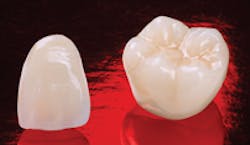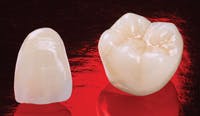Air rotor handpiece a more than worthy option
By Michael DiTolla, DDS, FAGD
My dad went to dental school in the early 1960s, and for his first three years in school, belt-driven handpieces were used. During hisDespite the objection of nearly half of the faculty, the students were issued this groundbreaking handpiece technology. The faculty was worried that students would mutilate teeth due to the increased efficiency or the air rotor. My dad says the day he got his air rotor was the day dentistry became fun.
About 13 years ago, I put my air rotors away and invested in electric handpieces, specifically the KaVo ELECTROtorque handpiece. After doing an in-house study at Glidewell that compared the ability of a dentist to polish ceramics with air rotors as compared to a lab electric handpiece, I wanted to go electric.
The nearly 100% increase in torque you get by going from an air rotor to an electric duplicated the high-shine, wet-gloss look the lab achieved. I was mostly happy with my choice to change to electric, but there were still some times when I missed my air rotor.
In 2013 I hired a talented dentist as an associate. She found the electric handpiece to be nice, but it was too big and heavy for her smaller hands. KaVo had just released its newest air rotor handpiece, the MASTERtorque M8900 (Fig. 1), so I bought her a couple of them. She was happy again.
Last month when my associate was on vacation, I worked on a patient and struggled to get to a second molar. My assistant asked if I wanted to try one of my associate's handpieces. So I grabbed her MASTERtorque air rotor, and was able to sneak right in for that nasty upper second molar.
I immediately noticed how short the vertical height of the handpiece head is. Even with a standard 19 mm bur in the handpiece, the total head height is only 20 mm.
I also struggled with this patient's prolific buccal fat pad that I had already nicked once with my electric handpiece. As the patient struggled to stay wide open, the patient's cheek would come flying in from nowhere toward the bur.
With the MASTERtorque, when I took my foot off the rheostat, the bur immediately slows down and is stopped within one second. It saved me from doing any more inadvertent soft tissue surgery.
I also noticed that the handpiece was noticeably quieter than any other air rotor I had used in the past. I am fairly sure the pitch of the noise it did make was closer to that of my electric handpiece as well.
So considering that roughly 70% of dentists in the U.S. still use air rotors as compared to electrics, I have one foot firmly planted in both camps now. I see there are enough advantages to each so I am going to have both available for whatever I might encounter clinically.
I went to trykavo.com and looked at the company's different options before settling on the MASTERtorque. I was amazed to see the company will ship the handpiece to you via FedEx, and let you try it five days for free. This type of confidence is rare in the dental field, and is a great way to test the product without feeling any pressure.
If you are looking to replace or add some air rotors, or have gone electric and want better access to second molars and pedo cases, the MASTERtorque is more than worthy of your consideration.
__________________
More by Michael DiTolla, DDS, FAGD:
- Another use for BruxZir solid zirconia
- Cordless done right with GingiTrac
- A triple tray for impressions
__________________


